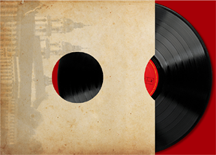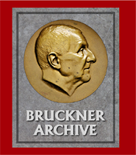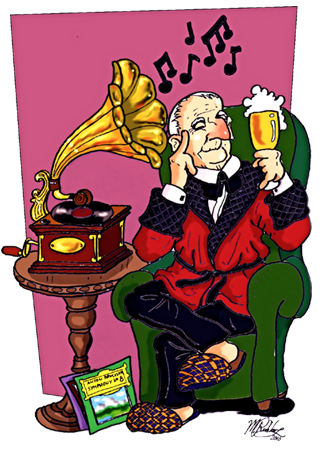Sol Siegel's Report on the Brucknerathon
3rd East Coast Brucknerathon - Simsbury, Connecticut, USA
A report by Sol L. Siegel
The third East Coast Brucknerathon (Fri.-Sat., 9-10 Sept. 2011) was a happy occasion for 15 committed Brucknerians who once again congregated at the Simsbury home of Ken and Ruth Jacobson to contemplate the great composer’s symphonic oeuvre. Several factors contributed to make this even a more relaxed gathering than the previous two. One was the smaller group, down from the earlier twenty-plus. The first was our peerless leader John Berky’s decision to play the symphonies out of chronological order, which had the effect of loosening up the proceedings. The third was the gorgeous late-summer weather, after recent batterings from a pair of tropical storms (one of which had just washed out a local road, necessitating a detour on the drive between Ken’s house and the Hyatt hotel in Windsor where most of us stayed), which made it too great a temptation to sit out on the back patio, drink beer or cola, and discuss all the things Brucknerian and otherwise musical that we hadn’t talked about at dinner the evening before, at a Windsor Locks restaurant where we had a room pretty much to ourselves.
The 6th Symphony made for a bracing opening (at 8 AM!) to the proceedings, especially as done by the Leipzig Gewandhaus under Heinz Bongartz, with a particularly lovely slow movement; too bad the CD was so poorly mastered, with shrill highs and weak midrange. John’s focus on underrated conductors continued with a live 1873 3rd (but with the 1877 final cadence) under Hans Zender that William Carragan claimed to be particularly fond of, for good reason. Vaclav Neumann’s superb recording of the 1877 Linz 1st, also with Leipzig, was marred only by a slowdown at the end. Slightly disappointing were the 7th, an SACD with the Vienna Symphony under the recently departed Yakov Kreizberg, and the live Haas 2nd with the Hessian Radio Symphony under the pioneering African-American conductor Dean Dixon: The former lacked the electricity I experienced in Kreizberg’s live performances of Russian music, while the latter seemed to lose focus after an excellent first movement.
The unnumbered symphonies were in good hands with the fairly familiar Rozhdestvensky F minor and a D minor from Takashi Asahina – not the one from his 1970s cycle but an exciting, if rough-and-ready, rendition from 1983 with the Tokyo Metropolitan Symphony.
In the midst of all this, Bill Carragan presented an audio file of his new two-piano transcription of the finale of the 1874 Fourth, explaining how it clarified the counterpoint (and how previous orchestral recordings have been taking the wrong tempi). And Benjamin Korstvedt offered an interesting presentation on how Bruckner reworked a single phrase in the finale repeatedly in the 1880’s. However, the excellent recording of the symphony by Franz Konwitschny received less attention, because lunch had arrived – a six-foot-long submarine sandwich that was quickly demolished.
As afternoon turned to evening, CDs turned to videos, beginning with a stirring 1984 NHK 8th under Lovro von Matacic. After dinner (Chicken marsala and another Brucknerathon cake, during which we sliced up images of not only the master but of John, Bill and Ben as well) came the 5th under Paavo Jarvi, in which the music – exciting but full of unstylistic scoops and crescendos – took second place to the players of the European Youth Orchestra, particularly the young ladies in their uniform blue starred gowns. Irreverently, I couldn’t resist speculating which of them Bruckner might have proposed to, after he had finished counting the stars on her gown.
At last came the 9th, the three completed movements beautifully produced and recorded live at Suntory Hall on a Blu-ray disc with Stanislaw Skrowaczewski and the Yomiuri Nippon Symphony. Skrowaczewski, now in his late eighties and frail, delivered a startling performance, with a fierce (though slower than this studio versions) opening movement leading directly into an equally fierce Scherzo, creating the effect of a two-movement symphony when contrasted with an unusually broad and brooding Adagio. The evening concluded with the recent Profil release of Gerd Schaller’s rendition of the Carragan realization of the Finale, but this was really anticlimactic after the Polish master’s confrontation with the abyss.
Bill presented us with a booklet of timed analysis sheets, which we used to follow the recordings of several of the symphonies. He also brought in a distinguished visitor, David Aldeborgh, whose lovely 1984 LP “Music of the St. Florian Period” is now available from John’s www.abruckner.com website. There were also freebies, including DVDs of the Dominican premieres of the Requiem and Te Deum. All in all, a splendid time – and this time I even got back to the Hyatt without getting lost.






